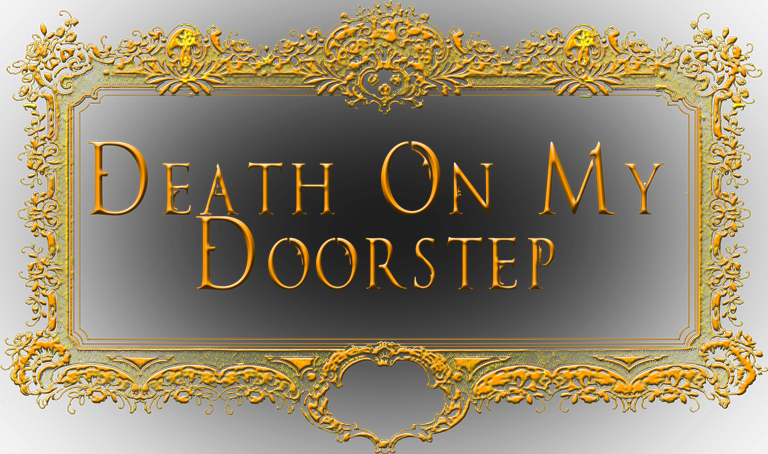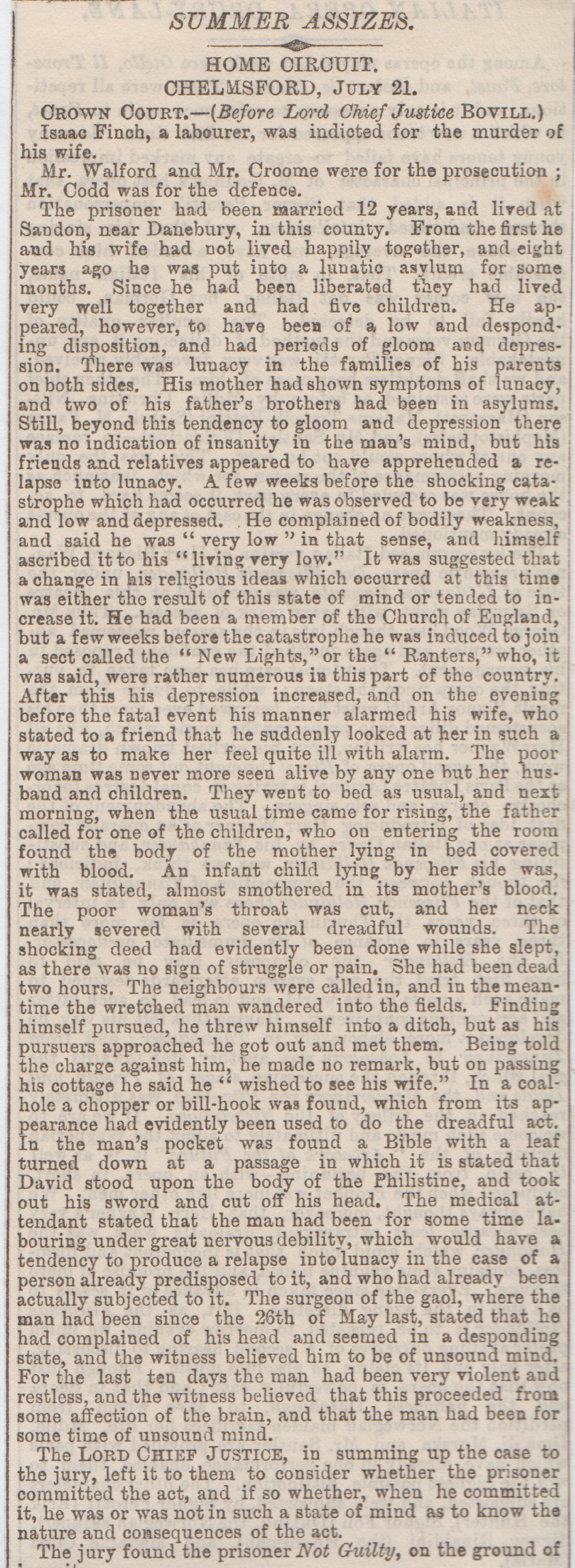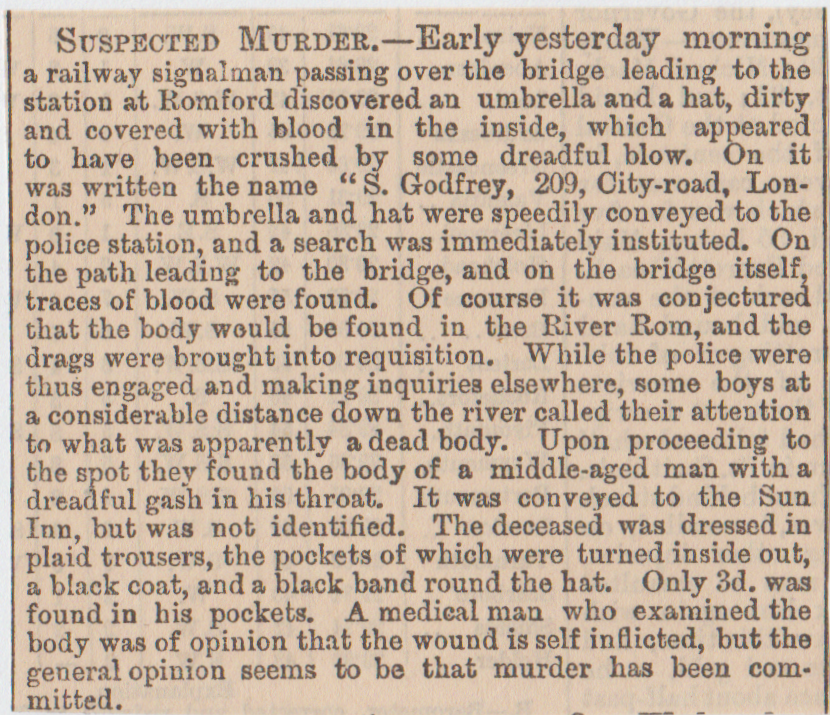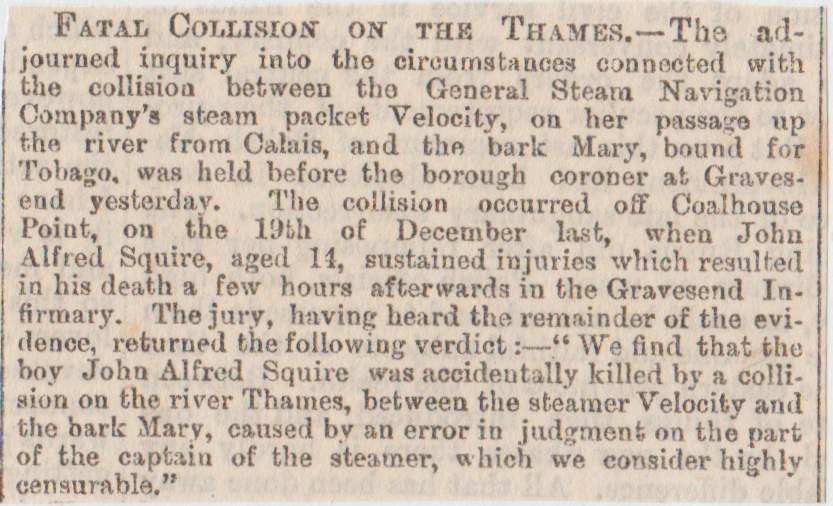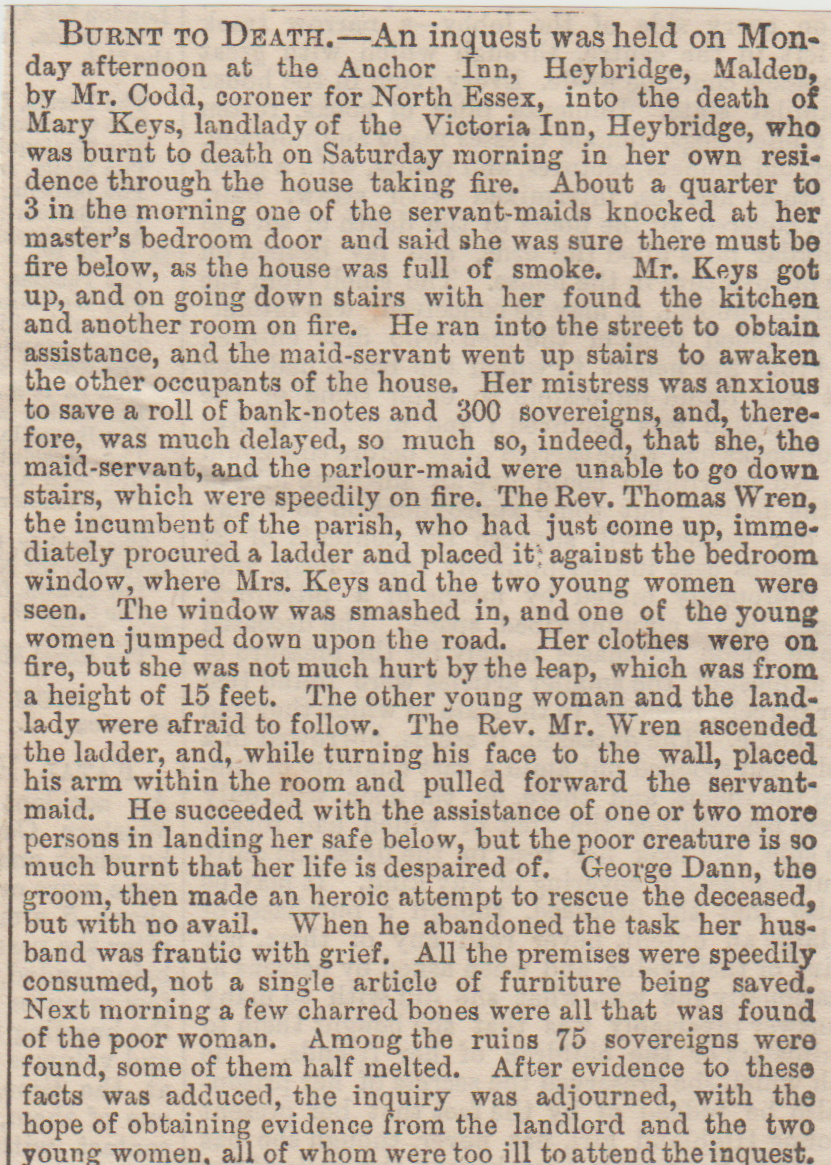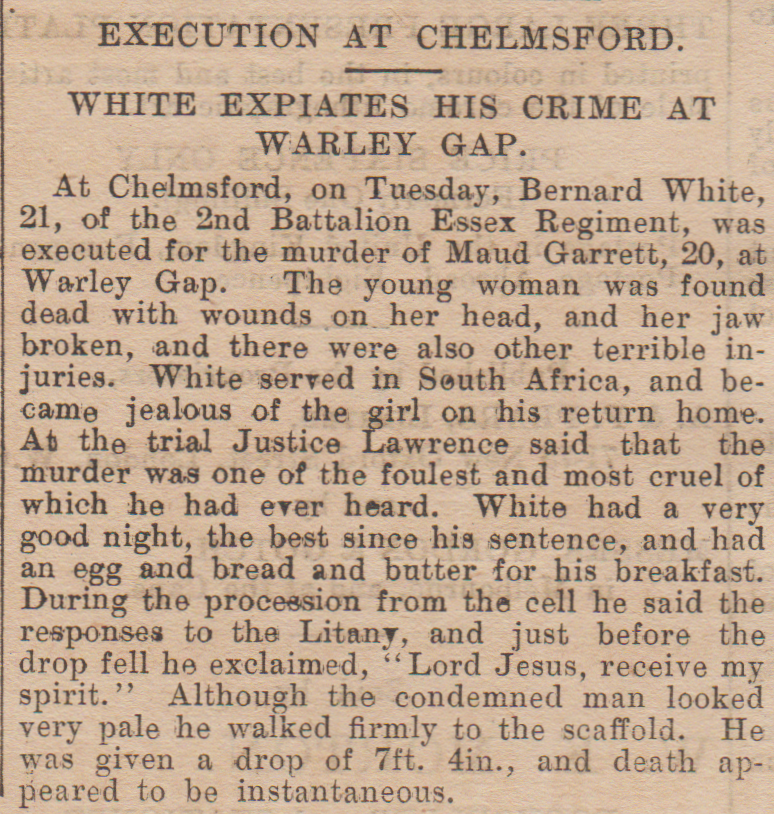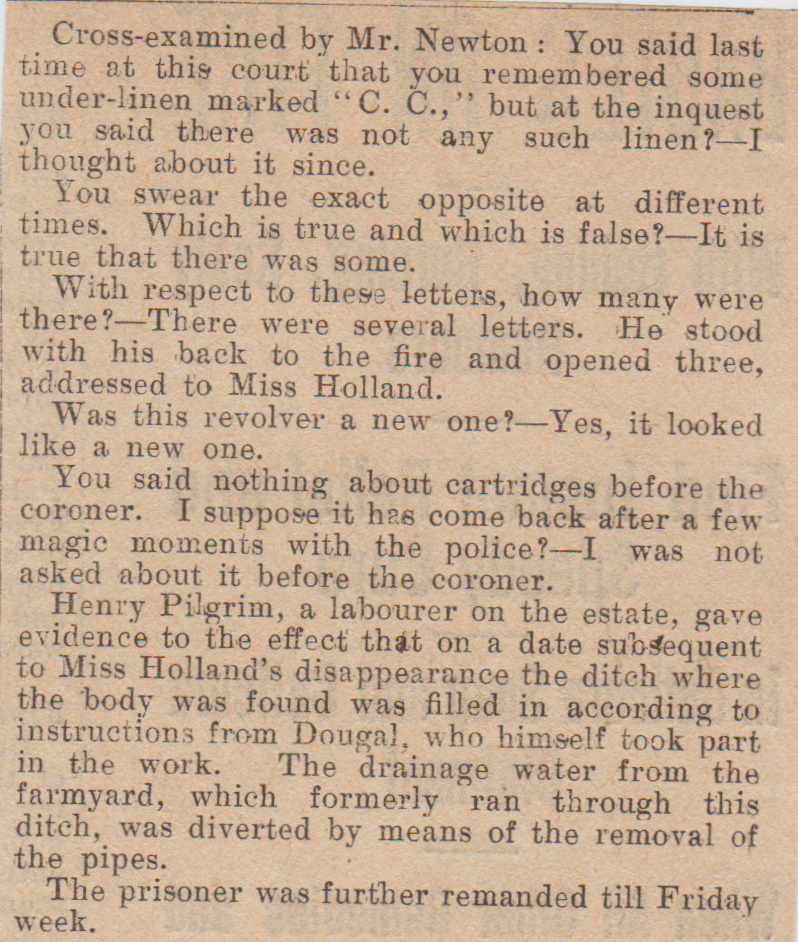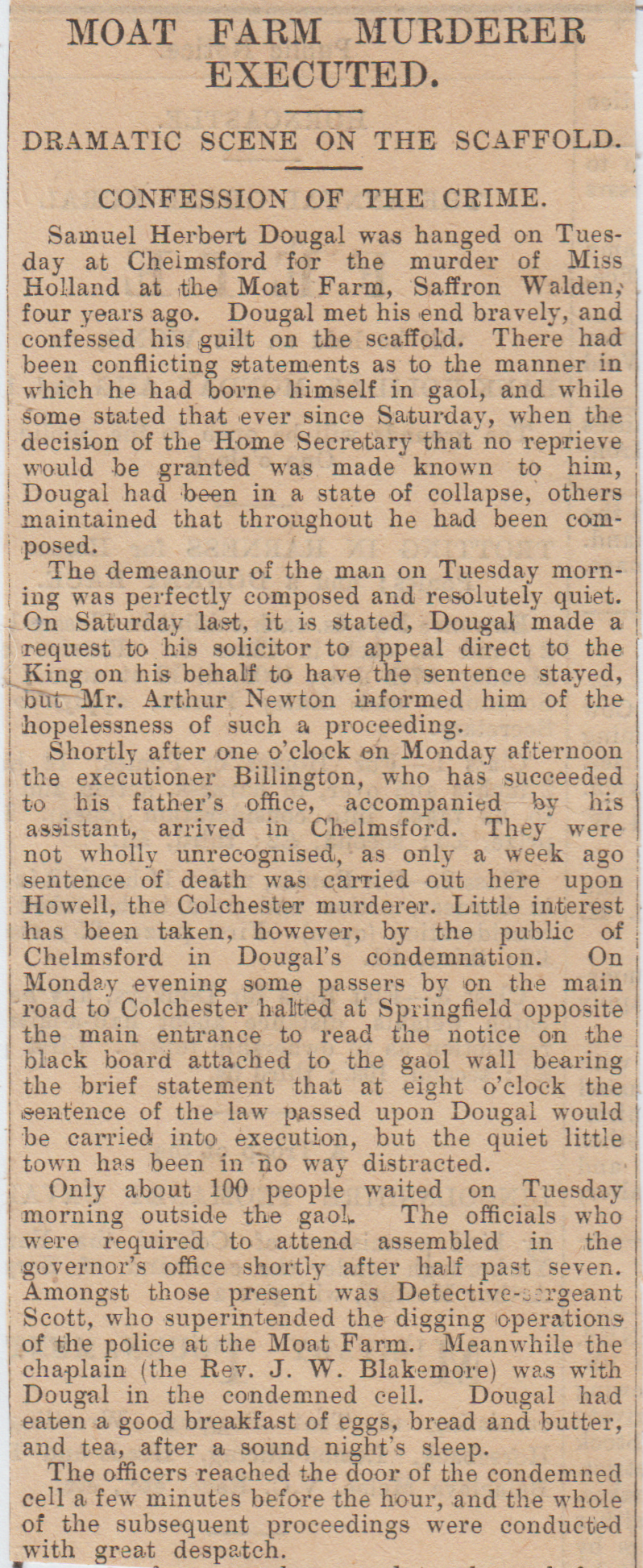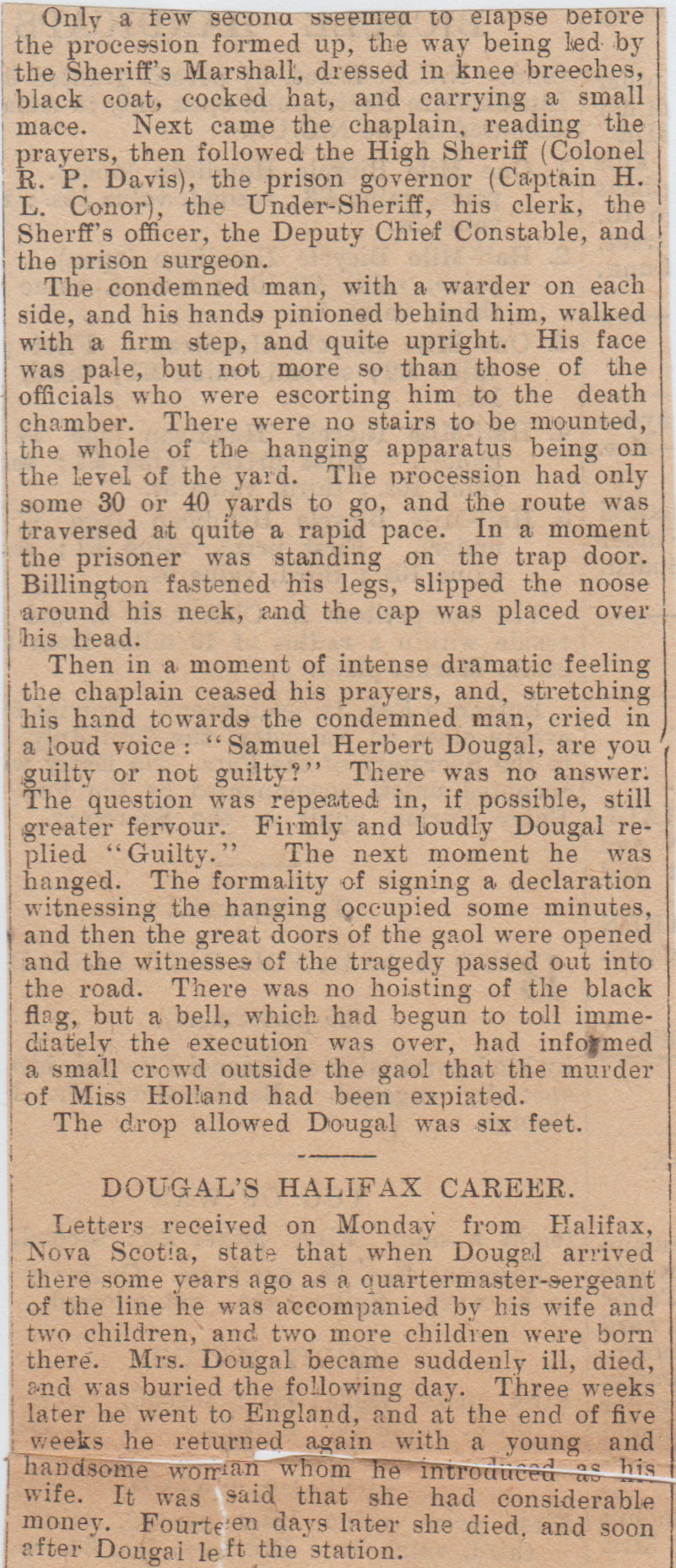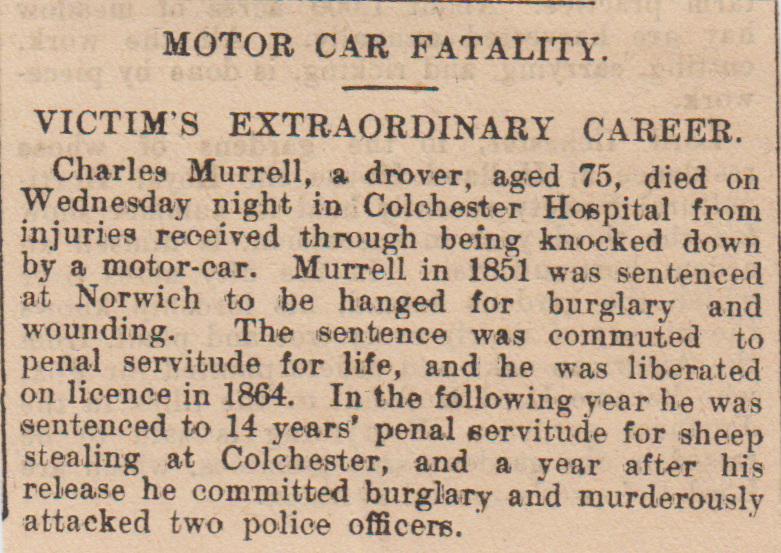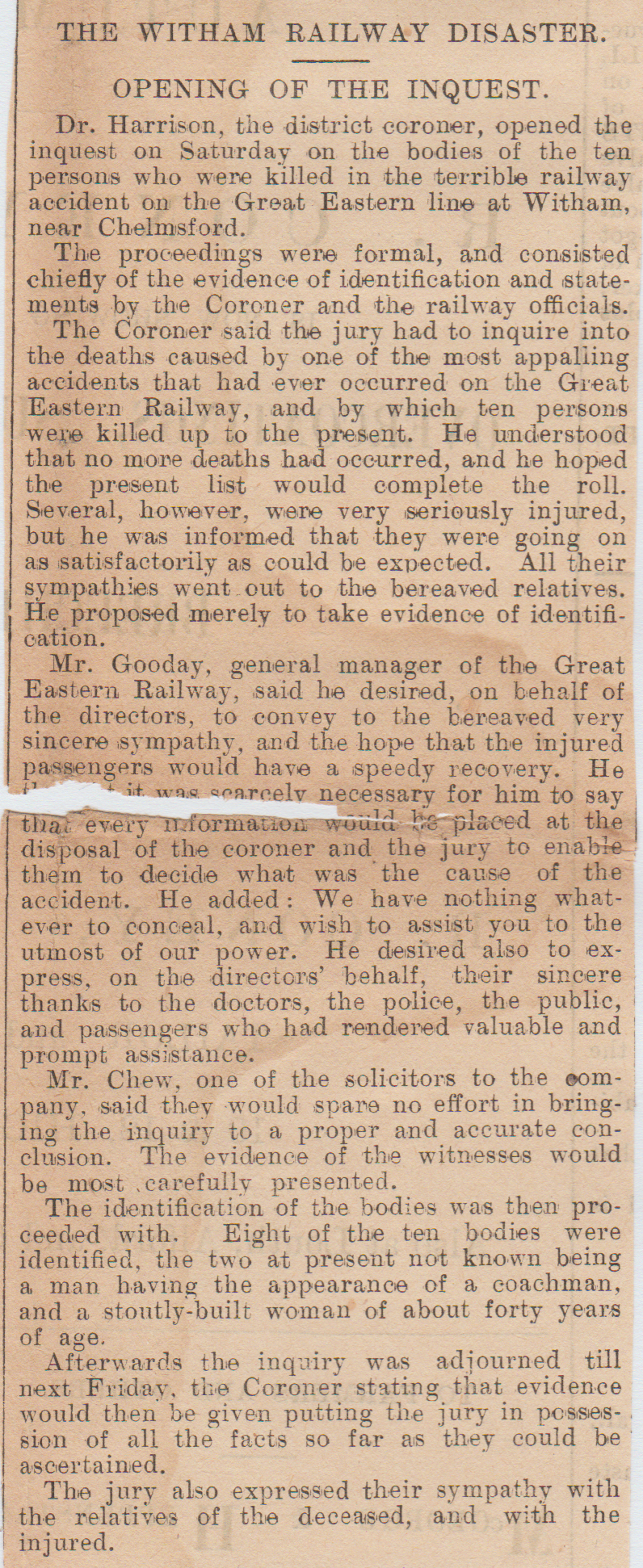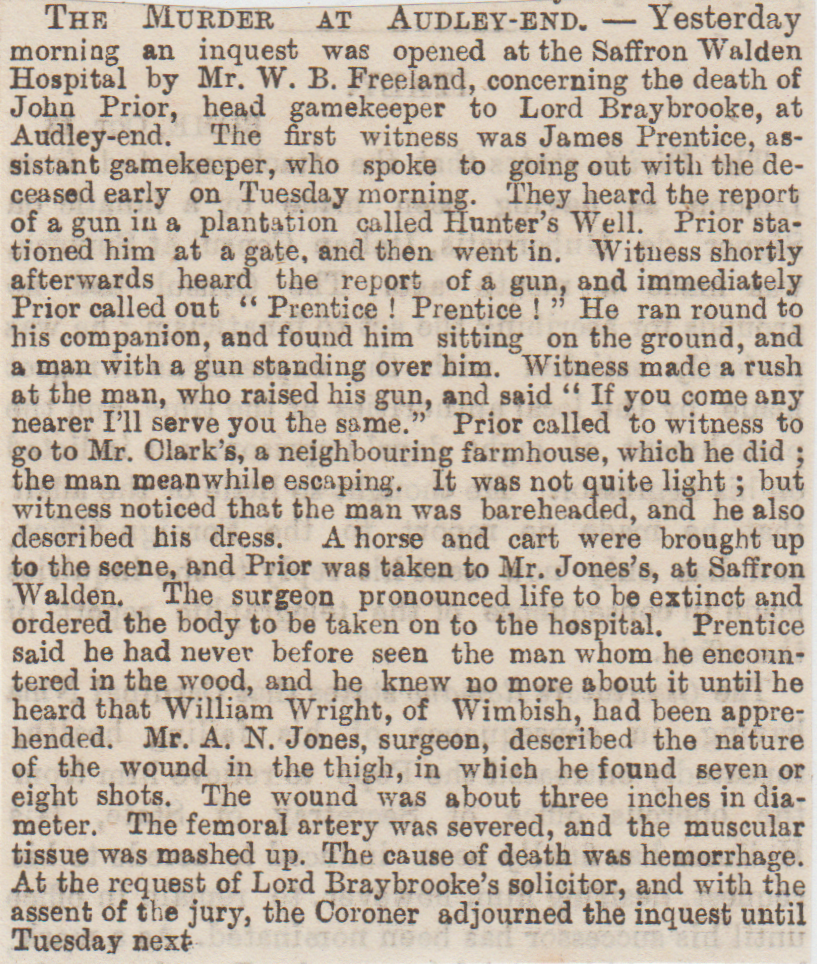1/ Bradwell-on-Sea, April 1895 (Weird Sh*t)
Neighbours reported to police about the family next door. They said the 15-year-old girl had been suspected of having a child. Police found a fully developed child in the chimney and when questioned she said that she had put it there. Here’s the freaky bit….the father of the child was her brother! When the brother was asked about this he agreed the child was his; another strange thing is that the parents and siblings all sleep in one room!
2/ Grays (Training Ship Blaze) December 1875 (How many died in the fire?)
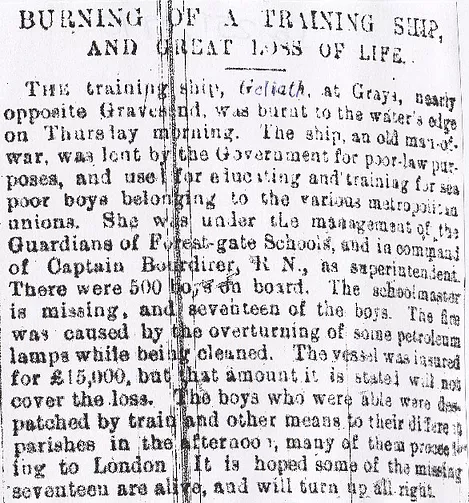
3/ Epping Forest Suicide, January 1885
I realise it’s a rather romantic image of Epping Forest but it’s all I had! This story is one of suicide and involves a 33-year-old decorator from Tottenham, William Henry Oats. He cut the skin between his thumb and forefinger with a pen-knife, then lay down on Mill Plain, Epping Forest, and bled to death. He had been despondent recently but showed no signs of suicidal tendencies. Oats leaves a widow, but no children.
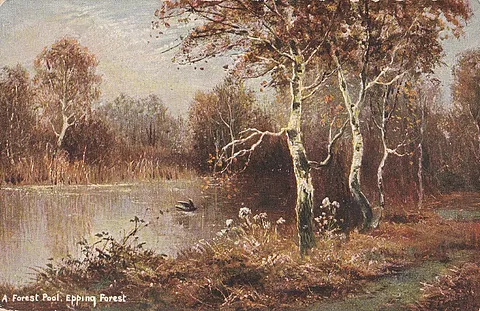
4/ Epping Forest Child Murders, July 1891
A mother of two confessed to the murder of both of her children. Mary Jane Heathcote, 28 years old from Kingston Road, Stoke Newington, said that she had drowned Florrie, only 3 years old, and Cissie, aged 5, in Epping Forest. Police eventually found the bodies in Connaught Waters. She was wandering near the Chingford Hotel wet through and distressed when she told a man named Higgs of her awful deed. The two bodies were removed to the Kingsland pub to await an inquest. After her confession, she was taken to Holloway Prison. During questioning, she was asked why she did it but could give no reason for the crime.
5/ Great Bentley near Colchester, July 1889

6/ Colchester Murder, June 1891
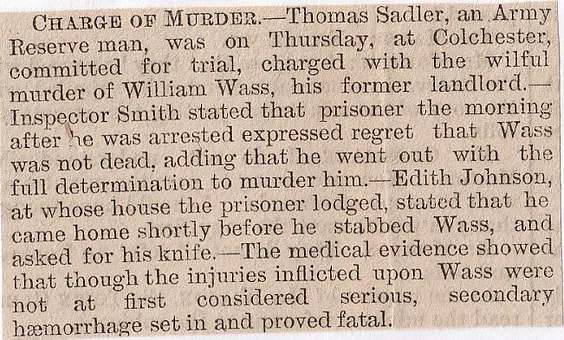
7/ Braintree Workhouse, July 1889 (Did Chandler Die?)
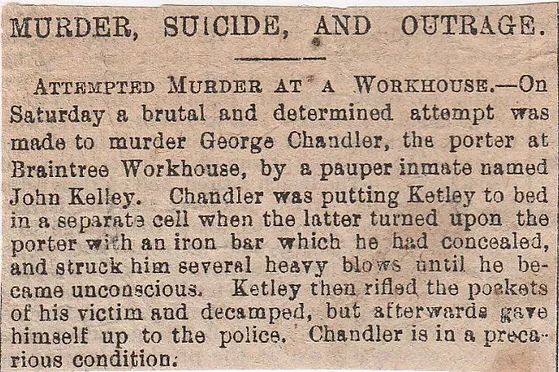
8/ Rainham Ferry (Body in a Bag) May 1887
The body of a woman who was tied up in a bag was discovered at Rainham Ferry. There was no identification at all and the post-mortem examination revealed she was about mid-twenties and had been dissected by a professional. (Butcher/Doctor?). About three weeks later a Mrs Cross from Richmond reported her daughter had been missing for that length of time. Mrs Cross described her daughter as erratic, feeble-minded and having a speech impediment. She liked to watch the boats at Richmond and she last saw her on 20th January (This was now June). She was twenty-eight and 5 feet 8 inches tall, dark eyes, short black hair, and good-looking. A strange occurrence happened to her previous to her disappearance, when a man stopped her and said he would take her home. She walked with him a while then he demanded her shopping and her purse saying he’d stab her if she didn’t give them up. She handed them over and he ran off, but she did go to Barnes police station and report it.
July 1887
Another parcel with cut up human remains in it, similar to those at Rainham, Waterloo Bridge and Battersea, has been recovered from the Thames, near to the place where the original discovery took place. It probably means that the whole body was thrown in the water at the same time but in separate parcels. One young lady has been looking for her sister who went missing and she tells of her sister dating a doctor. They both met each other in South London, and he got a practice in North London, so she moved there with him, however, she disappeared about 2 months ago.
9/ South Weald near Brentwood, October 1858 (Suicide)
Eliza Horn, a girl in the employ of a farmer by the name of Mr Benson, of South Weald near Brentwood, committed suicide by drowning herself in a pond that adjoined her boss’s property. It was discovered when a servant called Curtis saw what he thought was “some linen” in the pond. He pulled it into the bank and then saw the girl’s face staring up at him. He was badly shaken by the whole affair, so much so, that he went back to his parent’s house and then deteriorated and soon after died.
10/ Halstead Poisoning, January 1899
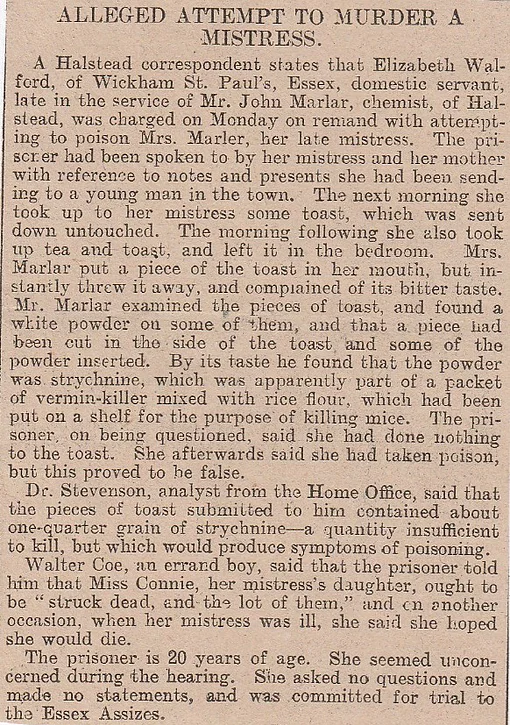
11/ Colchester (Body in River Colne) April 1867
The body of a woman was fished out of the river Colne and it was decomposed beyond recognition due to being in the water for about six weeks. Locals remembered hearing, in late February, screams for help from a woman from the direction of a garden next to the river. Deceased was Mary Ann Pettitt aged twenty-six, wife of a railway labourer, who’d left her in the Colchester Workhouse while he went looking for work. She was seen with Henry Draper Page near to the spot from which the cries were heard. She and Draper frequented a pub and went up the Ipswich Road. The last time they were seen was around 7-30 p.m., and when questioned said he was with her in the Rifleman, made a proposal to her but she wasn’t keen and he bid her farewell. The jury found him guilty of “Wilful Murder”, and he cried”Oh, my God! I am as innocent as the child in its mother’s womb. As Almighty God is in Heaven, I am innocent”, then he fainted. On his recovery, he added “I appeal to the Great Judge, if ever I touched that woman, or ever went to the side of the water. If I did, may Almighty God never forgive me. I go from here with a conscience fully knowing and feeling I never did the deed. So help me God”. ( What Happened? )
12/ Chelmsford, July 1880 (Lunatic Suicide)
Isaac Crabb had just been let out of Brentwood Lunatic Asylum, he then killed himself by hanging himself in a tree in Temple Wood near Chelmsford. He was about sixty and had been a labourer on the same farm for thirty years.
13/ Harwich, September 1885
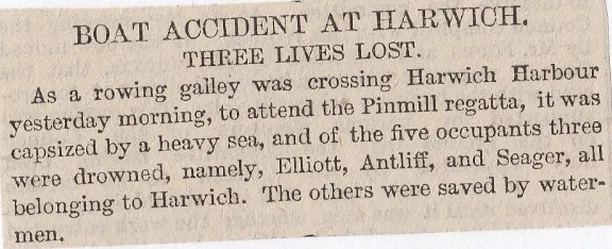
14/ Chigwell Road, Loughton, August 1881
Louisa Bass was a domestic servant in the house of a clergyman in Chigwell Road, Loughton. When Bass’s mistress noticed a foul stench she went into the scullery and saw her burning something in the fireplace. She asked her what she was doing and received a feeble excuse, so she had the place searched. When the fire was checked there was a little bundle in it, burning. She then asked her if she had given birth to a child but she denied it. On searching upstairs and opening a box, there was found the body of a baby. A doctor was called and he gave the cause of death as strangulation as it had a piece of cord around its neck.
15/ Southend, December 1909 (Vicar’s Suicide)
Rev.Henry Charles Lang the vicar of All Saint’s, was found dead in bed from the effects of prussic acid, and next to the body was a sensational suicide letter:-
“The only way! Do not inquire anymore. You will think me mad, but I am not. I cannot make that excuse. Do not think it is the religion which I have taught outwardly, but for some time have not really believed…I am agnostic-that is, do not believe in the possibility of a Deity existing, except as a creative principle or first cause…In spite of you and other things, life is unsupportable. You have been the only light in my life, but how unworthy I am of you. Forgive!”. – Mrs Lang said that her husband had been acting strange recently, but nothing suggested this.
16/ Lamarsh Murder, October 1897
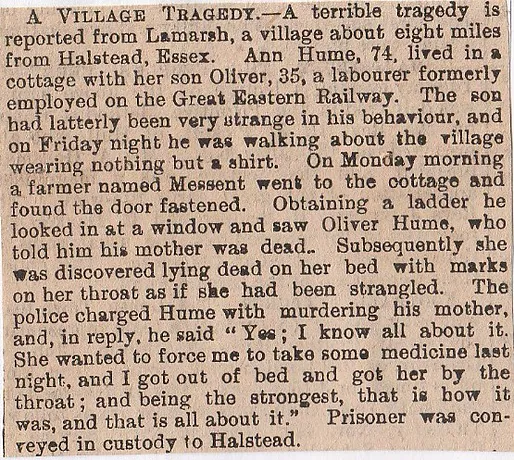
Oliver Hume, a railwayman, was formally remanded at Halstead charged with strangling his mother at Lamarsh. During the proceedings, prisoner fainted and on recovering consciousness shouted: “I did it; I was out of my mind”.
17/ Saffron Walden, March 1876 (Fifty-One Skeletons Found)
Discovered in the old Battle Ditches of Saffron Walden. The majority were barely under a foot of earth but one was deeper and more perfect, and in that was a glass bead necklace, three metal ornaments, and a large dagger, and some believe it is that of a Saxon chief. All but two were buried facing the West, some had broken bones and were battle-scarred. Another had a chunk of his skull missing. (Where are they now?)
18/ Upminster (Havering), August 1906
Mr William Abraham, from Upminster (Now in Havering), met with a singular death. He was blind in one eye, and he was shoving a stick in the ground in his garden when it snapped in two. This caused him to stumble and fall on another stick, which, by a million to one shot entered his good eye straight through to his brain causing instant death.
19/ Wix, June 1851 (Mary May’s Husband’s Suicide)
Mary May’s cottage in Wix, Essex, was the scene of her husband’s suicide when Robert May hung himself inside. Mary May was famous for murdering her half-brother, William Constable, by poisoning him for the insurance money. She was executed at Chelmsford prison in 1848.
20/ Wennington Filicide, near Rainham, November 1876
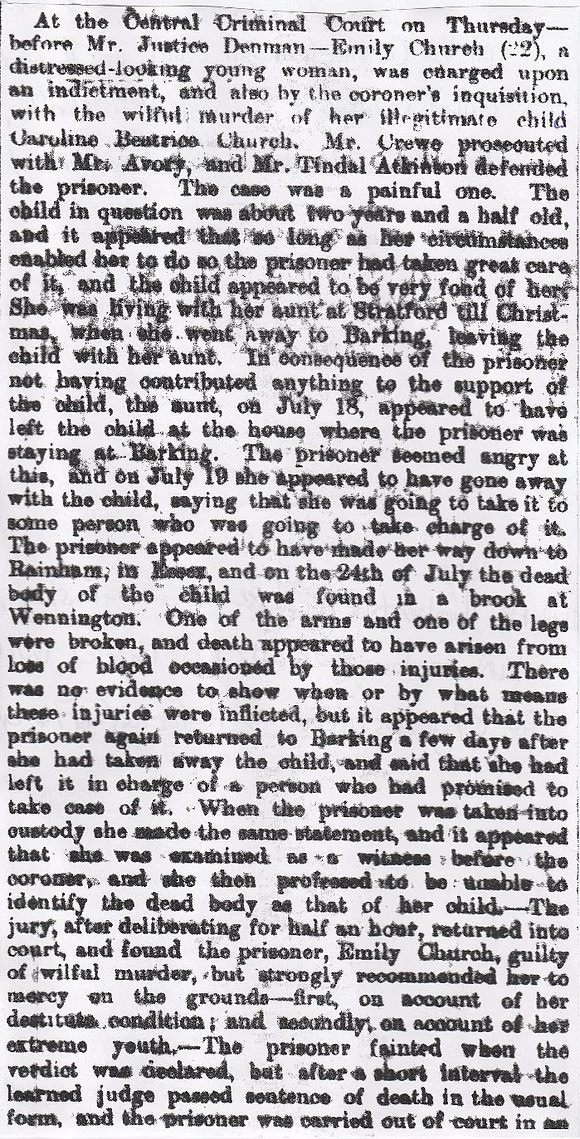
21/ Colchester, April 1867 (Human Remains)
The human remains found in the old bed of the River Colne had certain documents, found with fragments of the body, and these showed that the remains were those of Mr R.Worswick a railway contractor who vanished a year ago. Several large pieces of iron attached by wire to the body, as well as a carpet-bag containing some important papers, were dragged out or the river, along with the body. A cheque for £49 signed by “R.Worswick” dated over 4 years ago was found in the bag.
R.Worswick’s son, John, explained that he was 60 years old, and they were partners in the railway contractors. The last time he saw him was at his residence in Magdalen Street on November 22nd, 1865, and he told him he was off to Leicester to see his brother. He left Colchester and went to London where he stayed at the Crown Hotel, St Martin’s Court, Leicester Square. Whether or not he committed suicide was not ascertained, so a verdict of “Found Drowned” was returned.
22/ Black Notley near Braintree, June 1851
A farmer named Wynn, living at Black Notley near Braintree killed himself in an extraordinary manner. He was insane and had tendencies towards violence as well, and when his wife tried to prevent himself from getting a knife to harm himself with, he threw her off. She then got help, and herself and the man who’d she asked saw him hacking away at his throat. He then started to brandish the knife about so they backed off. He then ran towards a pond and threw himself into it. They dragged the pond and found his lifeless body covered in knife wounds and cuts.
23/ Crays Hill near Billericay, February 1898
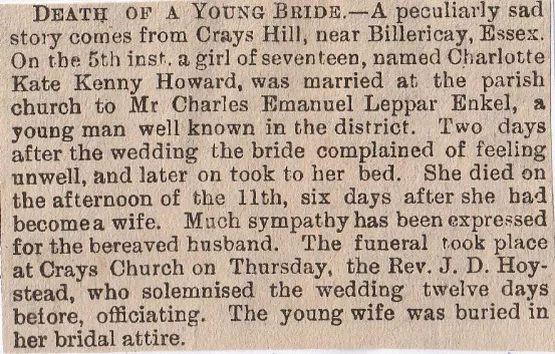
24/ Shopland Hall, Rochford, July 1845
Henry Truss attempted suicide, for the rather banal reason that he could plough a furrow as good as he wanted it to be. He saw his lacklustre effort then took out a penknife and made a couple of rather feeble efforts at making himself a second windpipe. He worked for Mrs Simmonds of Shopland Hall, Rochford, and that’s what I call a conscientious worker. Oh, by the way, he survived.
25/ Little Horkesley Hall Suicide, near Colchester, December 1888
Mr Thomas Bourdellon who was a magistrate for Essex committed suicide by drowning himself in a pond in the grounds of his property at Little Horkesley Hall near Colchester. The old fella was 88 years old and was depressed about his lack of health so he decided to bring it to an early end. (Little Horkesley Hall still there?)
26/ High Beach, Essex, June 1884 (Young Girl’s Suicide)
Jane Margaret Gibbings, only 19, committed suicide while living with her mother at Nile Cottages, High Beach Road. She had been a barmaid at the local pub and was seeing a young man named Charlie, but they had an argument, so as a typical melodramatic Victorian teenager would she killed herself. Her body was found in the water-butt and she left this rather curious last letter to her Mum:- “Tuesday night- My Dear Mother- When you hear of my distressing end you will, I know, break your heart. When I got into bed and had been there half an hour, the Devil paid me a visit. He stood talking to me for some time and he told me that he had seen Charlie- my young man with another woman. I said to myself, Now what can I do? To think he who I have loved so much should leave me for another. All of a sudden I thought of the water-butt and the more I tried to keep away from it the more the Devil tried to get me into the water. He said to me at last “If you jump in, I will get Charlie to bring you out. My head is raving and I feel on fire, I cannot say anything more. I have left my photograph in my box. Give it to Charlie and tell him that if it had been for him I should not have killed myself. I, however, did it for the best. Now, Mother dear, what the good of living! I was miserable and could not be happy without Charlie. Goodbye Mother. Give kind love to all. Your loving daughter, Jane Margaret Gibbings”. Verdict; Suicide while in a state of unsound mind.
27/ Colchester Child Murder, January 1885
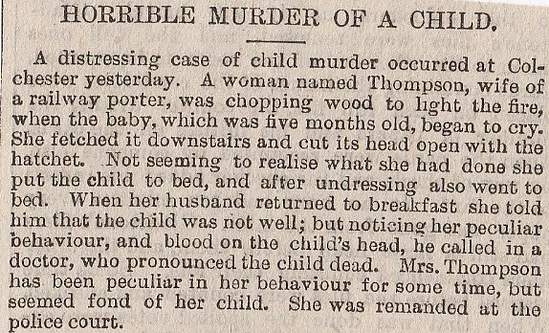
28/ Grays, January 1899 (Two Bodies in a Vat)
A brewer working for Seabrookes Ltd., Grays in Essex, by the name of Bream, found two bodies in a 500-gallon vat, one was George Byford, the other Edward Potter, of New Road, in Grays. The supposed scenario was that they were meant to clear out the vat and both went down, but the carbonic acid gas sort of suffocated them and they both passed out. They were taken out and sent to their own homes. Potter was married with children.
29/ Thaxted, January 1882 (Human Remains)
In Thaxted, there is a public house known as the Rose and Crown. It used to be a cheap lodging house, and when goods were being taken in the place, a floorboard was seen to be rotten so they were lifted up, and underneath were two human arms supposedly a child’s arms. Police searched further but nothing else was found. It is still there, but now is called the Maypole, it closed in 2009 as the Rose and Crown. In 1882 the landlord was Frederick Kifford, did he have anything to do with the child’s limbs?
30/ Saffron Walden Suicide, April 1890
At Rickling near Saffron Walden, James Bush from Maunden killed himself in a dreadful manner. One night he slept in a shed next to the Cricketer’s Arms and was discovered the next morning with a slash mark across his stomach with the innards spilling out. He was still alive, but when asked why he’d done this his reply was that he had done it while asleep. He lived a few more hours, then died.
31/ Brentwood Fire, June 1885
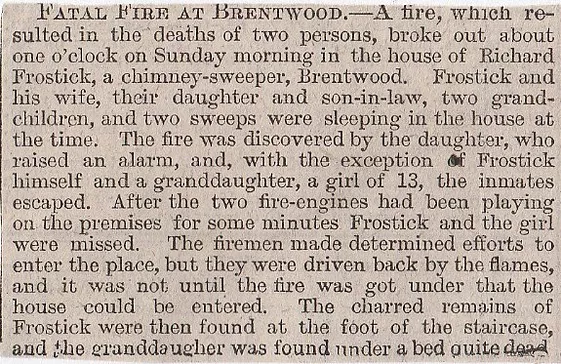
32/ Waltham Abbey, August 1900 (Lovers Suicide Pact)
The bodies of a man and woman were found in a field in Sewardstone; he is about forty-five, she is about twenty odd. They both had gunshot wounds to the head and police have figured out that he shot her first, then himself. Letters were found on the male which was addressed to the Danish Consul so they are presumed to be Danish nationals. In the letter, it states that they decided to die together, and despite the large age gap, they were lovers. The bodies were taken to Waltham Abbey Mortuary. (Who were they?)
33/ Essex County Asylum, Brentwood, April 1910 (Mysterious Deaths)
A couple of mysterious deaths have occurred at Essex County Asylum in Brentwood. Around 100 patients were outside in the grounds, and when taken back inside, Richard Pearson, from Claybury, and Alec Rayner from Chelmsford became seriously ill. The doctor was giving artificial respiration to one of them and the other died while he was doing this. They were known for eating any stuff off the floor, like worms. Neither of them died in the manner of a poisoning. They had rabbit for dinner but nobody else was struck down with any type of sickness. Post-mortem suggests that one died from syncope (low blood pressure fainting). The other was asphyxia. Doctors put it down to a coincidence that both died at the same time as coming in from the airing ground.
34/ Harlow, Essex July 1900
Alfred Edward Burton, of Feltimore Farm, Harlow, was in the garden picking peas with his missus when a bird flew past. Burton said to his wife that it was the same bird that pinched her currants, and went off to shoot it. His wife heard a shot but received no reply when she asked what he’d shot. She thought he’d ventured further out to get it and when she finally went up to the top of the garden, he was lying on the grass with his head blown away. Verdict “Accidental Death”.
35/ High Beach Suicide, April 1892
William Abergfell of 30 Endymion Road, Finsbury Park, in London, was found hanging in a tree in the High Woods at High Beach. Medical Officer said he’d been dead several hours and that the deceased used to be quite well off until he’d started gambling, and had lost huge amounts of his money. This was probably the only way out of problems he’d accumulated.
36/ Shoeburyness Explosion, February 28th, 1885

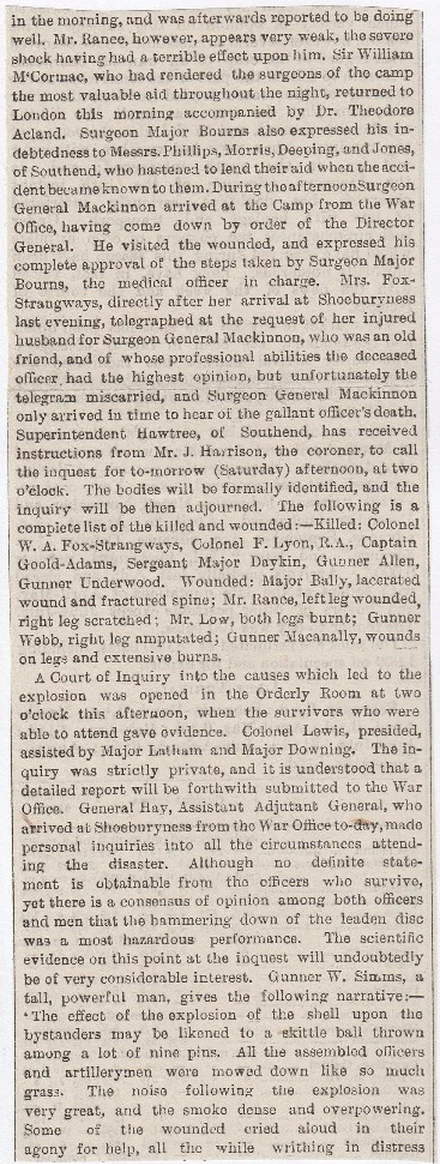
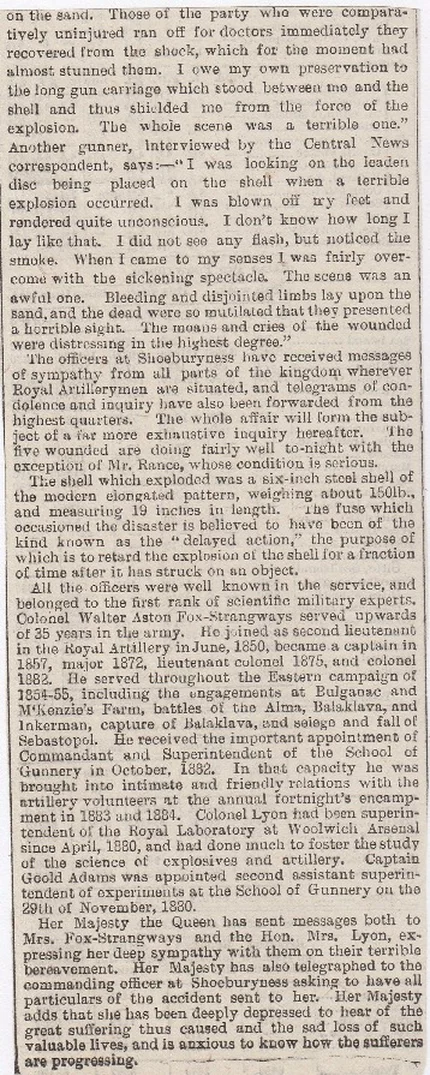
37/ Shoeburyness Explosion, March 7th, 1885
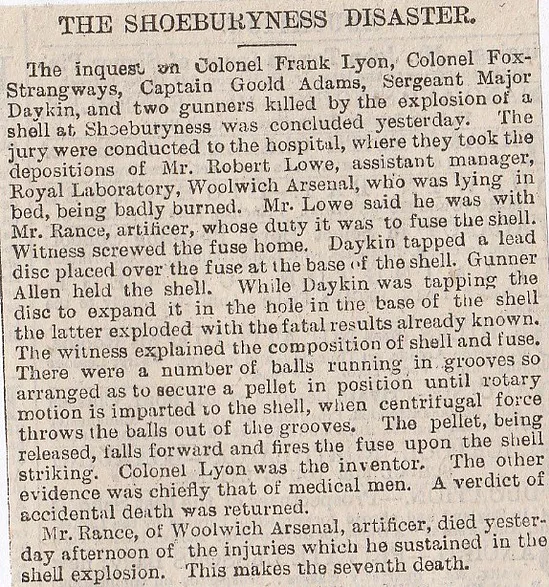
38/ Purfleet, (Body Washed Ashore) December 1880
This is an unusual story because when a body was found floating in the Thames near Purfleet, it was dressed in a man’s clothes, but it was a woman. She was wearing an 18-carat gold ring and gold studs and was about 20 years old and generally a good-looking lass. In the pockets were addresses of several City firms, and photos of her dressed as a man. A waterman by the name of Robert Owen saw her jump from Woolwich Pier around two weeks ago. The Met. had tried to identify the woman but without success so far. All her belongings are in the possession of Aveley police in case anyone can identify them. A verdict of “Found Drowned”.
39/ Marks Tey Station, December 1908 (Railway Death)
Thomas Lambert George was the manager of Smith and Son’s bookstalls at Marks Tey Station and was unfortunately killed in a freak accident. He was on the footboard chatting with a passenger when he jumped off, his coat snagged in the door handle and he fell under the train. His chest was crushed and neck was broken.
40/ Romford, March 1899
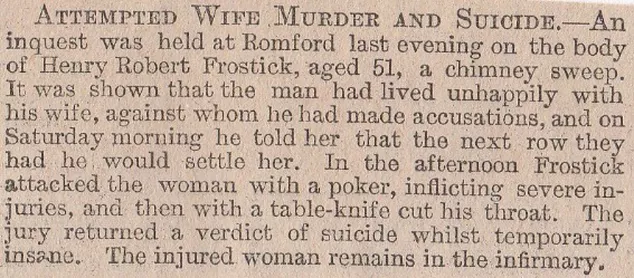
41/ Mountnessing, September 1893 (Riot at Funeral)
Edmund Peasey killed himself by laying his head on the tracks of the Great Eastern Railway and letting a train run over him. Peasey had been accused by his employer, Mr Hawkins, an innkeeper and baker of Mountnessing, of thieving from them. The jury censured the Hawkins for such a hasty judgment. The funeral at Mountnessing churchyard had 500 mourners and afterwards armed with sticks and bottles they went to the Hawkins house and made a racket outside for several hours. Someone threw some water over them from the top window of the inn that Hawkins kept, then all hell was let loose. They smashed windows and hurled objects at the rest of the building. Police arrived and managed to quell a potential riot and even worse a lynching of the Hawkins.
42/ Bradfield, (Anvil Death) May 1850
An accident at a wedding celebration resulted in the death of a blacksmith. It is custom in Bradfield, that when a blacksmith gets married there is a ritual called, “Blowing up the anvil”. The wedding was planned and Mr Scrivener had made the appropriate plans for the blowing up, which is a very dangerous act. A long iron rod was heated and gave it a blow with the hammer, when the powder exploded, probably from a piece of grit between it and the iron, and the sledge-hammer handle on which he was resting was driven straight through his body. He died instantly. He was 28 and married.
43/ Claybury Asylum Suicide, March 1899
A Mahommedan (Muslim) named Ben Zaat Sagheer, committed suicide in Claybury Lunatic Asylum by stabbing himself in the stomach with a pair of scissors. He died from septic poisoning from wounds sustained, and the jury stated that they thought one of the attendants named Harrold who gave evidence, was lying.
44/ Basildon Murders, September 1906 (see No.60 as well)
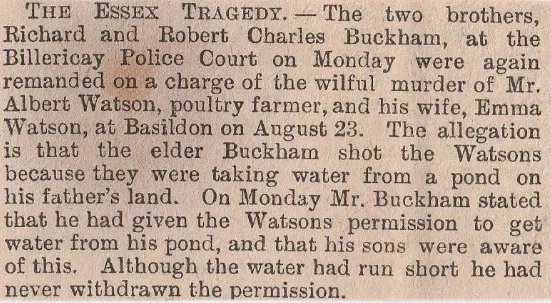
45/ Saffron Walden Child Murder, July 1897
Emily Pask and her father, Joseph Pask, were both charged with the murder of her baby boy. She had been a bit of a one, who had had several kids to her name with some dying in childbirth. She lived with her Dad at home and she did all the cooking and cleaning, but this was one child too many for Emily and Joseph.
46/ Southend, January 1885 (Wife’s Suicide)
The body of Ellen Bloxam, the 22-year-old wife of the second officer of the Royal Mail steamer, Tongariro, was found dead on the beach near to Southend. In November her husband set sail for New Zealand and told her he’d write to her from Tenerife in the Canary Islands. Due to bad weather, he didn’t get into port and his letters were taken to the Cape of Good Hope in South Africa. The wife grew anxious or thought he didn’t care so she went to the beach and drowned herself. This is a story that the moral should be “hold on for a bit longer”. The day after they found her dead body the expected letters turned up.
47/ Colchester (Railway Death) June 1889
On the arrival at Parkstone Quay of the Continental train, which passed Colchester at 9-13, the remnants of man’s body, along with bits of shirt cloth were found on the engine. The rest of him was found somewhere on the line and his features were obliterated. He was smartly dressed and had small hands and feet. The corpse was taken to the Railway Tavern at Colchester and was eventually identified as Frederick Ralph Merry, a former confectioner at Brentwood. He was now living in North Street in Colchester as a lodger of Mr Howe, a builder, and was about forty years old. Friends and family said that he had been acting strangely recently and even told Mrs Girvain of East Hill, that he was going to do himself in.
48/ Sandon Wife Murder, July 1870 (near Chelmsford)
insanity
49/ Chelmsford- A Boy’s Suicide, August 23rd 1870.
At Chelmsford yesterday a boy named Thomas Twinn, aged eight, committed suicide. He deliberately walked into the Chelmsford and Maldon Navigation River, whilst his ten-year-old brother stood quietly by and watched him drown. The boys had been gleaning corn, and their mother had threatened to thrash them for laziness. Their parents belong to the “Peculiar People”.
Inquest- August 24th 1870.
50/ Saffron Walden- A Gamekeeper Shot November 1870
51/ Suspected Murder at Romford, December 1866 ( Sun public house on London Road)
52/ Fatal Collision at Coalhouse Point, January 1867 (Coalhouse Point is near Tilbury East)
53/ Burnt to Death, Victoria Inn, Heyridge. April 1866
54/ Fatal Shooting at Chelmsford, December 1903
55/ Murder at Little Warley (Maud Garrett), November 1903.
December 1st, 1903.
Bernard White, aged twenty-one, executed at Chelmsford, for the murder of Maud Garrett. She was found dead with head wounds and a broken jaw, and other terrible injuries. White had become jealous of the girl on his return home. (He served in South Africa)
56/ Moat Farm Mystery, Clavering, May 16th,1903. (Murder of Camille Holland)
Moat Farm Murderer Execution, Chelmsford (Newspaper Article) July 1903.
57/ Death of a Career Criminal, Colchester. August 1904.
58/ Witham Railway Disaster, near Chelmsford. September 1905
59/ Suicide of a Girl at Pattiswick, near Braintree. June 1906
60/ Essex Farm Murders, Basildon. November 1906 (Sentence of Death- Also see No.44)
61/ Woman Kicked to Death, Lexden, Colchester. November 9th, 1907
Saturday, November 23rd, 1907
Charles Garnham, a ploughman at Viaduct Farm, Colchester, was charged on remand, at the local court, on Tuesday, with the wilful murder of his wife. At the inquest, the jury returned a verdict of manslaughter, but it was urged, on behalf of the Treasury, that the number of blows and their violence must make the case one of wilful murder. The accused was again remanded.
62/ Murder of a Gamekeeper, Audley End, near Saffron Walden. 14th October 1880
Wednesday, 20th October 1880.
The inquest as to the death of John Prior, who was last week shot by a poacher at Saffron Walden, which resumed yesterday. Evidence connecting a labourer named William Wright with the crime given; after five hours investigation the jury returned a verdict of “wilful murder” against him. The young man was positively sworn to by the assistant gamekeeper who accompanied Prior, and some things found at the scene of the murder tended to associate him with the deed.
Friday, 12th November 1880.
Petitions to the Home Secretary are being signed in Chelmsford, Saffron Walden, and at other places, praying that the sentence of death passed upon William Wright for the murder of John Prior, a gamekeeper in the service of Lord Braybrooke, may not be carried out, on the grounds that the prisoner had no intention of killing the deceased, that the finding of the hats of the two men and a button from the prisoner’s waistcoat on the ground suggested that there had been a struggle and that the jury strongly recommended the prisoner to mercy. If there is no intervention, the sentence will probably be carried out at Chelmsford Prison on the 22nd inst.
Tuesday, 23rd November 1880
Yesterday evening the Under-Sheriff of Essex and the Governor of Chelmsford Prison received a communication from the Home Secretary respiting during Her Majesty’s pleasure the sentence of death passed upon William Wright, labourer, aged twenty-three, for the murder of John Prior, gamekeeper, at Audley End, Saffron Walden. The petition in the culprit’s favour from Chelmsford and district bore 1063 signatures.
63/ Suicide on Chelmsford High Street. October 1880
In Chelmsford High Street yesterday afternoon, while the weekly market was at its height, a man named Ramsay took from his pocket a bottle containing oxalic acid and drank the contents. He fell to the ground, and, being picked up by the police, was carried into Shire Hall, where he died a few minutes later. Ramsay, who had lived in Chelmsford, was about fifty years of age.
